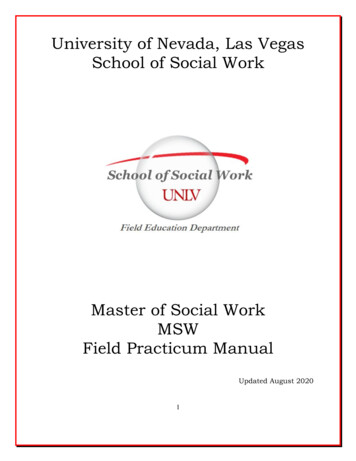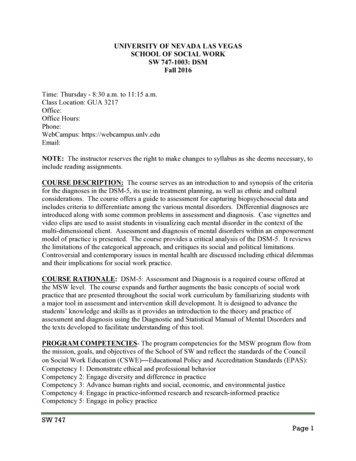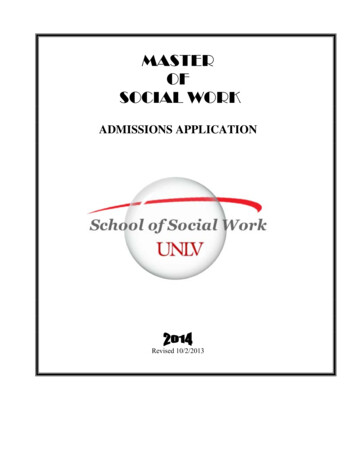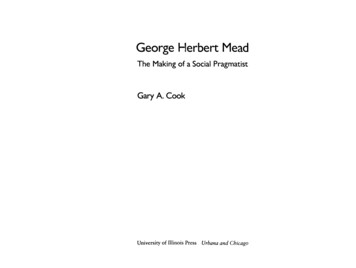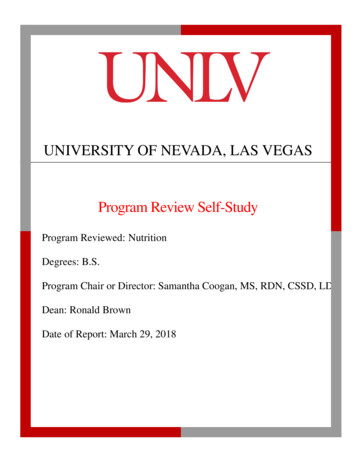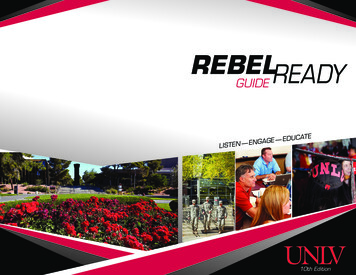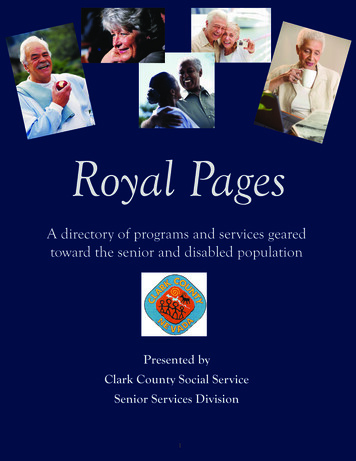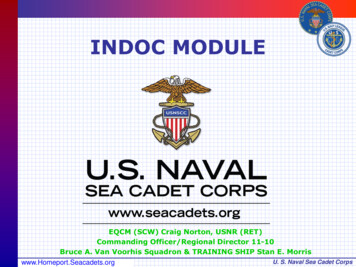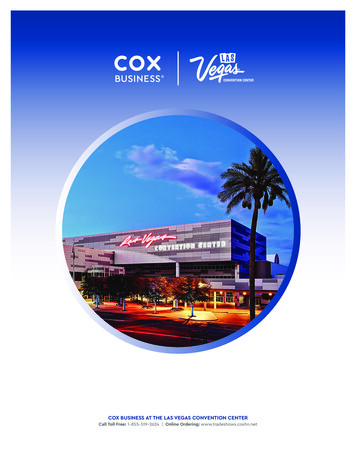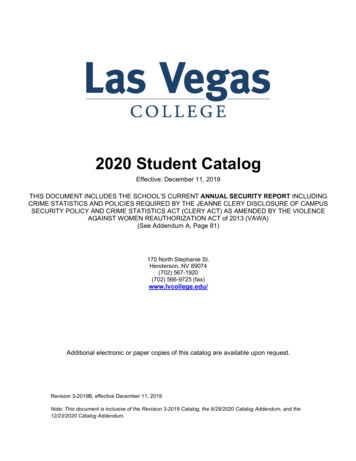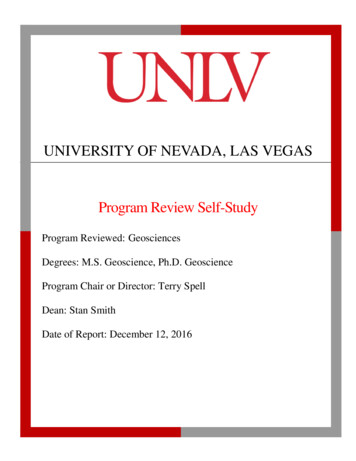
Transcription
UNIVERSITY OF NEVADA, LAS VEGASProgram Review Self-StudyProgram Reviewed: GeosciencesDegrees: M.S. Geoscience, Ph.D. GeoscienceProgram Chair or Director: Terry SpellDean: Stan SmithDate of Report: December 12, 2016
Program Review Self-StudyAcademic Year 2016-17GENERAL INSTRUCTIONS1. Please provide Faculty CVs as a single electronic file (PDF preferred) or on a thumb drive for the externalreviewers.2. Please complete the program review self-study using this template.3. If this review is covering several degree levels, please be sure to address each level in your responses to thequestions.4. Contacts for questions: Chair of the Faculty Senate Program Review Committee found ram-review or the Chair of the Graduate College Program ReviewCommittee found here: -committee Gail Griffin in the Office of the Vice Provost for Academic Affairs: Gail Griffin, gail.griffin@unlv.edu, 702-8950482.I.Program DescriptionA. College/Department/Program1. College or School: College of Sciences2. Unit: Geoscience Web address: https://geoscience.unlv.edu/3. Program(s) being reviewed: M.S. in Geoscience, Ph.D. in Geosciencea. Degrees and their abbreviations: M.S. GEOL, Ph.D. GEOLB. Primary individual completing this worksheet1. Name: Terry Spell2. Title: Chair and Associate Professor3. Date of self-study: November – December 20164. Campus Phone: x511715. Mail Stop: 40106. E-mail: terry.spell@unlv.edu7. Fax Number: 895-4064C. Other faculty involved in writing this report:Dr. Michael NichollDr. Rod MetcalfD. Please provide as Appendix 1 the most recent catalog description(s) of the program(s):1. Is the description correct? If not, what needs to be changed?The current catalog description of the M.S. degree is correct. The description of the Ph.D. degree has asignificant mistake regarding timing of the comprehensive exams which needs to be corrected. We arecurrently working on this.II.Centrality to MissionA. Department/Program MissionWhat is the program’s mission statement (or the department’s if the program does not have one)?The mission of the Department of Geoscience is to serve the needs of the State of Nevada by being an activeparticipant in the national and international geoscience community. We strive to provide an atmospherefor scholarly inquiry and creation of new knowledge emphasizing learning at undergraduate and graduatelevels that blends research, teaching, and service. To foster an informed citizenry by education, we provideUniversity of Nevada, Las VegasPage 2
Program Review Self-StudyAcademic Year 2016-17students with a broad understanding of scientific knowledge and principles, and equip them with the skillsto create and disseminate new knowledge and to function independently, collaboratively, and ethically withothers in the profession and society as a whole. We produce accomplished graduates who are well preparedto enter the work force or to continue their education in graduate and professional programs.The Masters of Science degree in Geoscience is designed to prepare students for a broad range ofchallenging careers in government service, private consulting, and industry. This thesis-based degreeprogram also serves as a stepping-stone for those students who wish to pursue further graduate studies atthe Doctoral level.The Doctor of Philosophy degree in Geoscience is designed to prepare students for demanding researchoriented careers in academia, government service, private consulting, and industry.B. Department/Program Mission AlignmentBriefly describe how this program is aligned to the mission of the University as described in the most recentmission statement, UNLV Mission http://www.unlv.edu/about/mission, and how it supports achievement of theinstitution’s mission:Our department and individual degree missions align well with UNLV’s Top Tier Mission in multipleways. We strive to positively impact the community and geoscience related industries by producingcapable, scientifically literate graduates who are informed citizens and employable. Our graduate studentsachieve gainful employment in a variety of industries, and many go on to hold faculty positions at otheruniversities. Many of our graduates work within the Las Vegas community, enhancing the quality of lifefor all by providing services to the water supply industry, the hazardous waste industry, and the buildingindustry. As such, we remain engaged with the Las Vegas, regional, and national communities in fulfilltheir needs.C. Core ThemesBriefly describe how this program supports UNLV’s Core Themes (the core themes can be found athttp://www.unlv.edu/about/mission):The graduate programs are very well tied to the three core themes. Student learning and success isfacilitated in our programs by integrated teaching and research. Detailed research and scholarship are atthe core of both the M.S. and Ph.D. degrees, with the final product being a thesis or dissertation which isorally defended before a committee. Our graduate student population is diverse. Some students have beenengaged in outreach programs with the Las Vegas community.D. ExcellenceList and briefly describe five highlights or areas of excellence of the program:1. Our programs are well known and our Department is ranked in the top 100 nationwide (we are theonly such department within the College of Sciences). Upon graduation a large majority of our MS andPhD students are continuing their professional career paths in Geoscience. We have graduated 63students from 2012 to present (46 MS, 17 PhD) and more than 90% have entered either a private sectorGeoscience position (Environmental/Engineering, Petroleum, Mining), academia (MS students to PhDprogram, Post-Doc, Research Scientist, Faculty position), or Government Agency.2. We take full advantage of our location in terms of the opportunity for field research. The departmenthas invested heavily in vehicles and equipment. Our setting here allows us to put students on a widevariety of outcrops and geologic settings within a 60-90 minute drive. Very few schools have thiscapability. In addition, few schools have a 9-month field season that coincides with the academic yearUniversity of Nevada, Las VegasPage 3
Program Review Self-StudyAcademic Year 2016-17(September – May). Much of our research often takes students elsewhere in the U.S. as well asoverseas. Graduate students in the Department have an array of analytical and sample preparationfacilities, including: the Electron Microanalysis and Imaging Laboratory, X-Ray Diffraction and X-RayFluorescence Laboratory, Structural Geology Laboratory, Nevada Isotope Geochronology Laboratory,Nevada Plasma Facility Laboratory (ICP-MS) Las Vegas Isotope Science Laboratory, EnvironmentalSoil Analytical Laboratory, Nevada Rock Deformation Laboratory, UNLV High Pressure Science andEngineering Center, Fluid and Melt Inclusion Laboratory, Optical Microscopy Laboratory, andmineral separation and rock preparation facilities.3. From the student perspective, our department sits in a middle ground between teaching and researchintensive. We have a very favorable faculty to graduate student ratio of approximately 1:3. As a result,our faculty have time to mentor our students while involving them in research programs. Graduatestudents benefit from robust external research funding support to Department faculty, supportinggraduate assistantships, fieldwork, and analytical work. The Department has averaged 1.9 million inexternal funding per year over the last 10 years.4. Our Geoscience programs are diverse. Currently our graduate students are approximately 58% maleand 42% female. This is close to the 2010 U.S. Census Bureau estimates of 49% male and 51% femalefor the United States. We are also well represented ethnically, with approximately 20% being Asian,2% black, and 8% Latino.5. The Geoscience Department offers a wide variety of research areas from which graduate students canchoose. A broad spectrum of the geosciences are represented by our graduate faculty’s research,including hydrology, volcanology, petrology, paleontology, geochemistry, planetary geology, medicalgeology, tectonics, sedimentology, high pressure mineralogy, paleoclimatology, and economic geology.Our nationally and internationally recognized faculty grouped into six major research fields: Petrology& Geochemistry (eight participating faculty), Tectonics and Structural Geology (eight participatingfaculty), Climate and Surface Processes (four participating faculty), Hydrology and EnvironmentalScience (three participating faculty), and Planetary Science (three participating faculty). The differentresearch areas are supported through student access to state-of-the-art research equipment.Additionally, our students benefit from relationships between the Department and the Desert ResearchInstitute (facility adjacent to campus). DRI research faculty, particularly those in with researchHydrology and Environmental Science, and in Climate and Surface Processes, routinely serve asGraduate advisors and committee members.III.External Demand for ProgramA. Stakeholders1. Who are the main local and regional stakeholders of your educational programs, i.e., employers and entitiesbenefiting from these programs, hiring the graduates, or admitting them to graduate and/or professionalprograms?UNLV Geoscience programs focus on the study of the Earth and some of humanity’s most importantproblems including energy, water, and mineral resources; the environment; climate change; and naturalhazards such as volcanoes and earthquakes. The stakeholders of the UNLV Geoscience departmentinclude our students; alumni; private industries, government entities, and academic institutions whohire our students; and citizens of the State of Nevada and country who are served by our researchactivities. Industry stakeholders include private consulting firms that specialize in the areas of energy,mining, geotechnical engineering, water development, and environmental remediation; and companiesproducing precious metals, petroleum, and construction materials (sand, gravel, gypsum, concrete).University of Nevada, Las VegasPage 4
Program Review Self-StudyAcademic Year 2016-17State and Local government agency stakeholders include the Southern Nevada Water Authority,Nevada Division of Environmental Protection, Nevada Department of Transportation, Nevada StateEngineers Office, and Nevada Bureau of Mines and Geology. At the regional scale, similar agencies inArizona, New Mexico, Utah, and California also benefit from our programs. Our programs serve localand regional offices of Federal government agencies including the US Geological Survey, US Bureau ofReclamation, US Department of Energy, US Bureau of Land Management, and US EnvironmentalProtection Agency. Educational institutions, from local (e.g., Clark County School District, College ofSouthern Nevada, Desert Research Institute), to national, are served by our programs and graduates.2. What are specific stakeholder needs for graduates?Employers require graduates who are able to work well in a cooperative environment with others,design studies, synthesize data and formulate logical conclusions from it, and produce clear technicalwriting.B. Needs for Graduates and Future Plans1. What are the anticipated needs for program graduates over the next 3-5 years? Please cite sources ofinformation.The Geoscience Department trains students for several career pathways that are tracked by the USBureau of Labor Statistics (BLS). According to the most recent (2015) Occupational Outlook Handbookpublished by the BLS Earth Science jobs are expected to grow at a rate equal to, or better than thenational average for job growth (7%).Environmental Scientists and Specialists – the BLS predicts that 10,200 new jobs will be addedbetween 2014 and 2024, which amounts to about 11% of the current workforce. The 2015 medianyearly pay for this job description is 67,460.Geoscientists – the BLS predicts that 3,800 new jobs will be added between 2014 and 2024, whichamounts to about 10% of the current workforce. The 2015 median yearly pay for this job description is 89,700Hydrologists – the BLS predicts that 500 new jobs will be added between 2014 and 2024, whichamounts to about 7% of the current workforce. The 2015 median yearly pay for this job description is 79,550.Natural Sciences Managers – the BLS predicts that 1,800 new jobs will be added between 2014 and2024, which amounts to about 3% of the current workforce. The 2015 median yearly pay for this jobdescription is 120,160.Expected growth in the above occupations is attributed to environmental concerns and populationgrowth. At the regional level, we are currently seeing a decline in hiring by the multi-national miningand petroleum companies; however, future improvements in the economy are likely to lead to hiringincreases. The smaller companies in those fields are continuing to hire, largely associated with domesticnatural gas production and exploration for the raw materials associated with energyproduction/storage. Employment related to climate and water resource development is strong andappears to be driven by regional drought in the southwestern United States.2. What changes to the program will those require?We do not anticipate that changes to our current programs are required to meet these needs.University of Nevada, Las VegasPage 5
Program Review Self-StudyAcademic Year 2016-17C. Success of Graduates1. What steps does the department take to facilitate the success of graduates (e.g., internships, career fairs,employment talks, etc.)?The Geoscience Department holds weekly seminars by invited external speakers each semester. Theseprovide graduate students the opportunity to be exposed to new research ideas, learn about potentialgraduate advisors at other universities, and to meet these individuals. Each year ExxonMobil sends arepresentative to our department for a multi-day recruitment effort. Many of our students havereceived internships and employment through these interviews. Each spring semester the departmentholds a student run 2 day scientific research conference called Geosymposium. During this eventstudents gain experience presenting results of their research as well as meeting the numerousrepresentatives from industries that employ geoscientists. Most of our graduate students haveexperience travelling to, and presenting at, professional scientific conferences, such as the GeologicalSociety of American and American Geophysical Union annual meetings.2. Discuss the placements of recent graduates:The Geoscience Department does not systematically collect data on placement of graduates. Unofficialtracking indicates that our recent graduates are currently working for ExxonMobil, the Bureau of LandManagement, a few different mining companies in Nevada, the U.S. Geological Survey, and at variouscolleges/universities.3. If the department or program does not have placement information on graduates, what is the plan to implementgathering that information?At this time, there are no plans to collect data on placement of graduates.3. Do placements match stakeholder needs as identified above in A of this section?Unable to answer at this time.4. If not, please explain.Collecting data on placement of graduates has been discussed internally, but for a number of reasonshas not been implemented. First and foremost, UNLV does not consider this a priority in terms ofallocating resources to departments. Secondly, anecdotal evidence suggests that students are selfselecting a broad range of career paths (graduate school, government agency, private consulting, multinational corporations, K-12 education, sales, etc.) and employers. As a result, attempting to identifycommonalities would not be statistically feasible.5. Does the program assess whether the graduates are meeting employer’s needs? 1We are broadly aware of the needs of employers who our graduates typically work with. Employers ofgeoscientists require graduates who are able to work well in a cooperative environment with others,synthesize data and formulate logical conclusions from it, and produce clear technical writing.Although we are confident that we produce graduates with these qualities, at the present time we haveno quantitative means of assessing this outcome.1This is a new question to respond to recently implemented program review enhancements by the NSHE. (3/16)University of Nevada, Las VegasPage 6
Program Review Self-StudyAcademic Year 2016-176. If not, what will the program do to get this assessment in place and by what date?2The Geoscience Department will institute plans for a questionnaire to be sent to typical employers. Thiswill seek specific feedback on what needs they have for Geoscience graduates they are consideringemploying. We will seek to complete this task by the end of Spring semester 2017.7. Additional CommentsIV.Program ResourcesA. Faculty Time1. Faculty and GA ResourcesNumber of InstructorsFall 2014Spring 2015Full Time Faculty1214GA1919PTI02FIRS & Visiting30All others10Number of ClassesTaughtFall 2014Spring 2015Full Time Faculty2128GA2832PTI04FIRS & Visiting911All others20Fall 2014Spring 2015Full Time Faculty32373651GA376366PTI01522491931340Percent of ClassesTaughtFall 2014Spring 2015Full Time Faculty35.037.3Student Credit HoursTaughtFIRS & VisitingAll others2If the program has no employer expectations information, there must be a plan to put such a program in place and it has to be stated.(3/16)University of Nevada, Las VegasPage 7
Program Review Self-StudyAcademic Year 2016-17GA46.742.7PTI05.3FIRS & Visiting15.014.7All others3.30Fall 2014Spring 2015Full Time Faculty54.961.2GA6.46.1PTI00.3FIRS & Visiting38.132.4All others0.60Percent of SCHTaught2. For other non-major courses – e.g., upper division for the college or university, estimate the unit’s resourcesallocated to them:The Geoscience Department does not run these types of courses at the graduate level.General Education1. If your program or unit offers General Education courses, please estimate what proportion of the unit’sresources are allocated to this area:There are no general education courses at the graduate level.2. Does the combined load from A and B affect your unit’s ability to offer courses for its major?If so, please describe: not applicableB. Budget1. Please fill in the table with three years of financial expenditures to be used to respond to questions 2 and 3below.Budget categoryFY 13-14State Operating (2101)Student FeesIndirect Cost RecoverySelf-supportingTotal Allocations Number of Graduate Assistantships(including GAs on grants)366,85914,25324,30146,58291,995FY 14-15 343,07232,6563,06439,67378,465FY 15-16 3,17339,44320,03634,51297,164342. Are these resources sufficient to meet the degree program’s instructional and scholarship needs?University of Nevada, Las VegasPage 8
Program Review Self-StudyAcademic Year 2016-17Student Fees are sufficient, however, the classes that don't charge special fees are paid from the StateOperating account (2101). Depending upon which expenses are allowable in the Special Fees account(65CJ), the state account would need additional funds for class supplies (line 30), analyses (line 30),maintenance of equipment (line 30) and field trip expense (line 15 & 30).The Geoscience Department GA allotment is insufficient. Most ( 80%) of our GA positions arededicated to 100-level course laboratory sections which are almost exclusively taken by students fromoutside our department. Because of the need to offer these courses we often face a shortage of GA’s tocover our major class laboratories. The Geoscience needs an additional 3-4 GA’s each year to effectivelycover all of our laboratory sections. Note that our total GA count has actually decreased from the FY13-14 number.3. If not, approximately what line items and amounts would be needed?Additional
1. Who are the main local and regional stakeholders of your educational programs, i.e., employers and entities benefiting from these programs, hiring the graduates, or admitting them to graduate and/or professional programs? UNLV Geoscience programs focus on the


